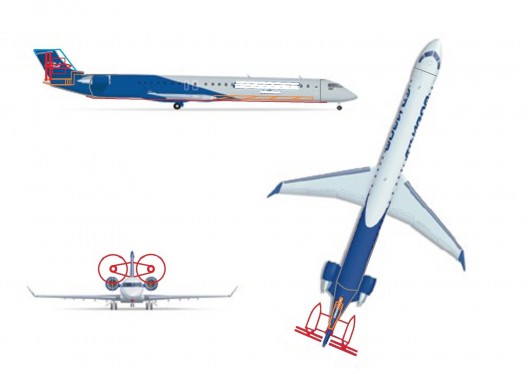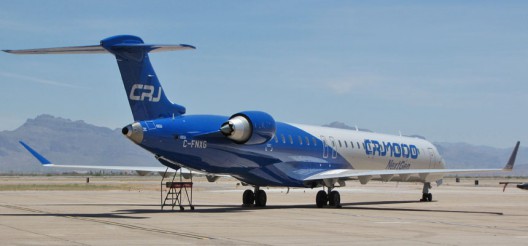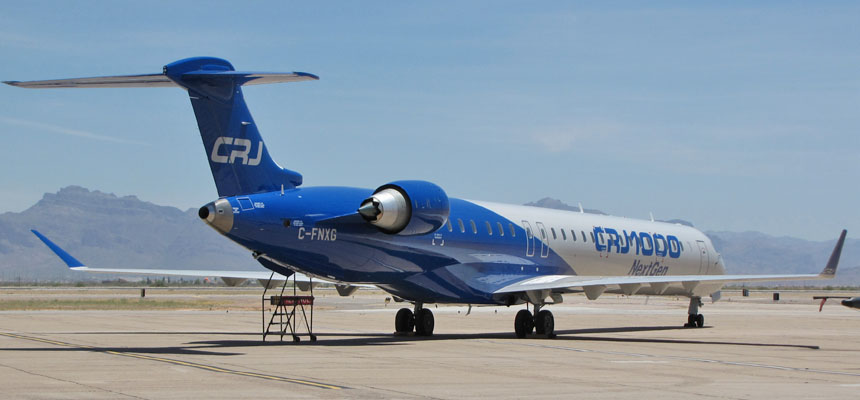Teslarati, the forum for Tesla fans, includes a fascinating concept for an electric/jet airliner, as proposed by Peter Egan, a web-site member from Artarmon, New South Wales, Australia. His proposal could be applied to smaller jet airliners in anything up to the Boeing 737 or Airbus A320 class.

CRJ1000 modified for hybrid electric flight, 2,500 kilometer (1,550 mile) range with reduced fuel use. Note horizontal tail is replaced with elevator/motor mount system. Conventional jet engines would be removed in this version and are shown for size comparison
He uses a Bombardier CJR1000 100-passenger regional jet for his example, and shows a large motor pod-elevator replacement on each side of the fin, with counter-rotating propellers on either side of the rudder. (Whether this arrangement would be aerodynamically or structurally sound remains open to investigation.) His concept drawing includes the existing General Electric-CF34-8C5A1 turbofans for comparison, but they would be removed.
The GE engines put out 13,630 pounds (60.6 kiloNewtons) of thrust at takeoff. Peter substitutes a pair of twin- motor/counter-rotating propeller units, each with: two permanent magnet electric motors, rated at 1,200 kW (1,608 hp.) continuous power, with 1,400 kW (1,876 hp.) each available for takeoff. That totals 5,600kW (7,506 hp.) for take-off, from motors weighing 280 kilograms (616 pounds ) each and totaling 1,120 kilograms (2,464 pounds).
A single Pratt & Whitney PW127TS – 1,864 kilowatts (2,498 hp.) continuous with 2,386 kW (3,198 hp) take-off power would power two 1,000 kilowatt (1,340 hp.) (up to 1,200 kW, or 2,608 hp. for takeoff power) generators to provide energy to the batteries. Batteries in turn consist of forty 21.15 kilowatt-hour modules for a total of 846 kW.h – 5.75% above the airplane’s nominal capacity of 800 kWh. They would give a battery-only range of 100 kilometers (62 miles) with a 10 kilometer reserve (6.2 miles) if the APU fails, enough in most circumstances to find a safe landing. Peter adds to that the altitude glide reserve plus battery reserve. This all adds up to about 12 minutes flight time without the APU operational.

CRJ1000 in more conventional form
To support the aircraft, a Tesla tug would tow the airplane to the end of the runway before takeoff and a 1,000 kW charger would bring batteries up to full charge while the airplane is parked. Wheel motors will taxi the aircraft and help it accelerate to takeoff speed.
Peter calculates a “25 percent improvement in fuel economy expected compared to 86 seat Bombardier Q400 turboprop.” The same motor/APU concept could be applied to other aircraft in this size and weight range, according to Mr. Egan. You can see more details on this interesting proposal here.
Certainly, with growing concern over environmental and health issues regarding fossil-fuel powered jet liners, improvements in fuel economy and a concomitant reduction in emissions will be welcome. Peter Egan’s concept is a launch point for many possible iterations and variations.

